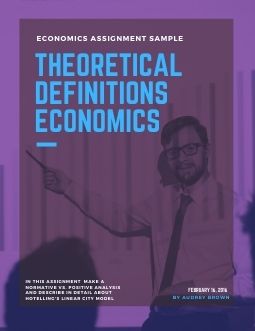
You can download the sample Economics essay on Theoretical Definitions Economics with the following question for free at the end of this page. For further assistance with Economics Assignment help, please check our offerings in Economics assignment solutions. Our subject-matter experts provide online assignment help to Economics students from across the world and deliver plagiarism free solution with a free Turnitin report with every solution.
(AssignmentEssayHelp does not recommend anyone to use this sample as their own work.)
Economics Assignment Question
Make a Normative vs. Positive Analysis?
Describe in detail about Hotelling's Linear City Model?
Economics Assignment Solution on Theoretical Definitions Economics
NORMATIVE vs. POSITIVE ANALYSIS
While talking about normative analysis, we generally refer to the opinions based on value judgments, without considering the available facts and figures. Based on theoretical foundations, this analysis is carried out on a subjective mode. For example, if we look at the foundations of game theory, it becomes clear that subjective judgments come with probabilistic choices, and that is solely based on contextual arrangements. However, boundary conditions are majorly not considered in this case, as normative analysis is subjective in nature and therefore, considering a phenomenon as a boundary or not is totally subjective in nature.
On the other hand, when we talk about positive analysis, we generally refer to the opinions based on available facts and figures. If the analysis is done based on a particular theoretical foundation, and if the analysis of the data on any particular context does not that theory, then in accordance with the positive analysis, the theory has to be disproved in that particular context. For example, if we consider the Environmental Kuznets Curve hypothesis in the context of a developed and a developing country, then we can see that the curve may hold in the context of a developed nation, but not for developing nation. Therefore, the hypothesis has to be disproved in the second context, based on the economic development and emission data available in that context…
Read more in the complete solution PDF document at the end of this page.
HOTELLING'S LINEAR CITY MODEL
Let us assume that the city is of unit length. Two firms are located at 'a' from the origin, and 'b' from the other end. An indifferent consumer is in the x* position from the origin. The cost of transportation for any consumer is tX2 (X = distance) and the cost of the product is 'c'. The entire set of consumer is assumed to be distributed uniformly along the length of the city. The model of the city is shown in Figure 1.
Figure 1: Configuration of the city in Hotelling's model
If the prices offered by the firms are given by pA And pB, then for indifferent consumer, the cost aspects will be given by,
pA + t(x* – a) 2 = pB + t(x*– B) 2
or, x* = (a + B) / 2 + (pB – pA) / 2t (B – a) … (1)
Where, B = 1 – b
Due to positional disadvantage, the consumers on the right to x* will prefer firm a, and customers on the right to x*, will prefer firm b. Therefore, for firm a, the market share will be x*, as the consumers are uniformly distributed, and for firm b, the market share will be 1 – x*.
(Some parts of the solution has been blurred due to privacy protection policy)


 WhatsApp Us
WhatsApp Us